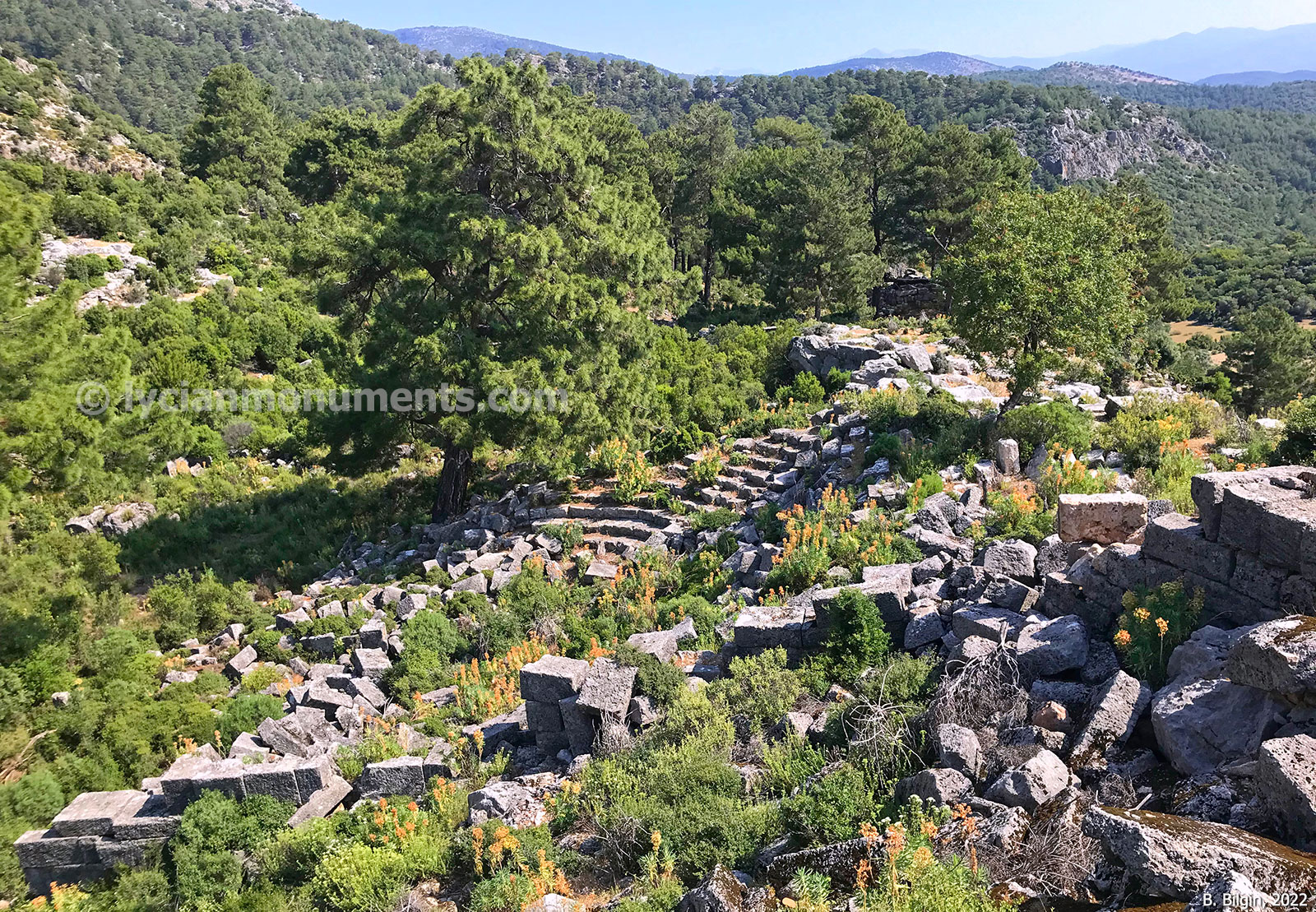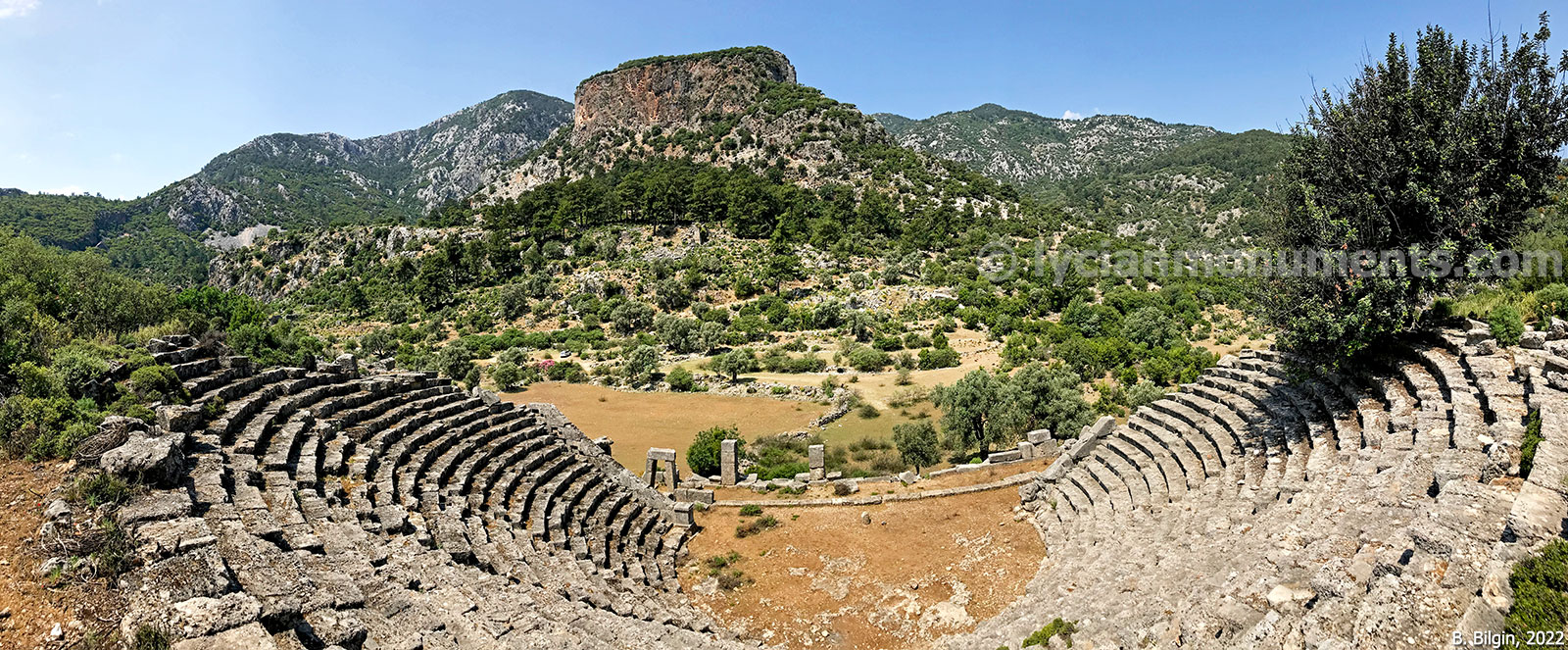The city of Pinara is located on the eastern slopes of the South Antikragos Mountains (Baba Dağı) to the east of Fethiye Bay and overlooks the Xanthos Valley. It was built on terraces rising from 330 meters to 715 meters. It is bordered by the cities of Xanthos in the south and Tlos in the northeast. The Lycian name of the city was Pinale (or Pilleñni). Ancient writers rarely mention Pinara. Charles Fellows was the first to identify the city in the modern period. Since no excavation work has been carried out yet, the oldest findings do not go back any further than the dynastic period, but it is known to be much older because the name of the city is also mentioned as Pinali in the 13th century BCE Hittite texts. There are coins minted with the name of the city from the dynastic period. It was also one of the first cities to mint money under the name of the Lycian League in the 2nd century BCE. In the Roman period, as stated by Strabo, Pinara was one of the 6 big cities in the Lycian League with 3 voting rights each. However, in later periods, Pinara lost this privileged right to Telmessos, which grew rapidly thanks to its large port. Pinara continued to exist as a bishopric center from the Byzantine period until the 12th century. Except for the fortification walls in the upper acropolis, which are surrounded by steep slopes, there is no Hellenistic structure in the city. The upper acropolis contains very few building remains. The Roman period construction is built on a lower slope to the east of this steep hill. Except for the tombs, all of the visible remains, such as the bouleuterion, temple, agora, and bath, belong to the Roman and Byzantine periods. The theater building with a capacity of 3200 people, also of the Roman period, was built on the opposite slope of the plain under the lower acropolis.
The most striking structures in the city are the tombs. It is possible to see almost all types of Lycian tomb architecture in Pinara. Hundreds of pigeonhole-type rock-cut tombs cover the steep slopes of the upper acropolis. Some of the most beautiful examples of wooden architecture-imitating house-type rock tombs in Lycia are found on the rocks around the city. About a dozen of them also contain Lycian inscriptions. One of these classical rock-cut tombs is particularly striking with its wall reliefs that depict the city of Pinara. These are quite helpful to understand the urban texture of the city during the dynastic period. There are also pillar tombs from the dynastic period and sarcophagus tombs from various periods.
Creek Necropolis of Pinara
Rock-Cut Tomb with Reliefs
Southern Necropolis of Pinara
Sarcophagus of Ddapssm̃ma
Pinara Theater
References:
Benndorf, O. & G. Niemann. 1884. Reisen in Lykien und Karien (Reisen im südwestlichen Kleinasien I), Wien.
Çevik, N. 2021. Lykia Kitabı: Arkeolojisi, Tarihi ve Kültürüyle Batı Antalya, Türk Tarih Kurumu, Ankara.
Fellows, C. 1847. Lycia, Caria, Lydia, illustrated Mr. George Scharf with descriptive letter-press by Sir Charles Fellows, London.
Tietz, W. 2016. ‘Central Lycia: Kyaneai, Phellos, Kekova’, in From Lukka to Lycia: The Land of Sarpedon and St. Nicholas, eds. H. İşkan & E. Dündar, 362-373, İstanbul.
Wurster, W. W. 1980. ‘Survey antiker Stadte in Lykien’, Actes du Colloque sur la Lycie antique, 27-36.
Wurster, W. W. & M. Wörle, 1978. ‘Die Stadt Pinara’, AA 1978, 74–99.
Image sources:
O. Benndorf & G. Niemann, 1884
C. Fellows, 1847
W. W. Wurster & M. Wörle, 1978
W. W. Wurster, 1980
British Museum
Tayfun Bilgin, 2022
Ertuğrul Anıl, 2024
Bora Bilgin, 2022, 2024

















































